
Chapter 7: Cell Structure and Function
7.1 Life is Cellular
The Discovery of the Cell
In 1665, Robert Hooke used a microscope to look at thin slices of cork from plants that seemed to be made of many tiny, empty boxes; Hooke called these boxes “cells,” and they are the basic units of life
The cell theory states that all living things are made up of cells, that cells are the basic units of structure and function in living things, and that new cells come from existing cells
Exploring the Cell
A microscope gives you a larger view of something very small, such as a cell
Light microscopes use glass lenses to focus light and magnify the object
Light microscopes can make clear images of objects only to a magnification of about 1000 times
Electron microscopes produce even higher magnifications by using electrons instead of light
Electron microscopes can show things that are 1 billionth of a meter in size
Transmission electron microscopes send beams of electrons through thin slices of cells and tissues
In scanning electron microscopes, a beam of electrons is scanned over the surface of an object to give a three-dimensional image of the object’s surface

Prokaryotes and Eukaryotes
Despite their differences, at some point in their lives, all cells have DNA - the molecule that carries genetic information; all cells are also surrounded by a thin, flexible barrier called a cell membrane
There are two main kinds of cells: one kind has a nucleus, and the other does not
The nucleus is a structure that contains the cell’s genetic material in the form of DNA and controls many of the cell’s activities
Eukaryotes are cells that enclose their DNA in nuclei
Prokaryotes are cells that do not have nuclei and their DNA is not separated from the rest of the cell
Eukaryotic cells are generally larger and more complex than prokaryotic cells
Eukaryotes can be very different from one another; some, like “protists,” live as single cells, while others make up large organisms with many cells (plants, animals, and fungi)
Prokaryotic cells are generally smaller and simpler than eukaryotic cells
Even though they are simpler than eukaryotes, prokaryotes do all the activities that living things must do to be called “alive:” they grow, reproduce, respond to the environment, and, in some cases, glide along surfaces or swim through liquids
The living things that we call bacteria are prokaryotes
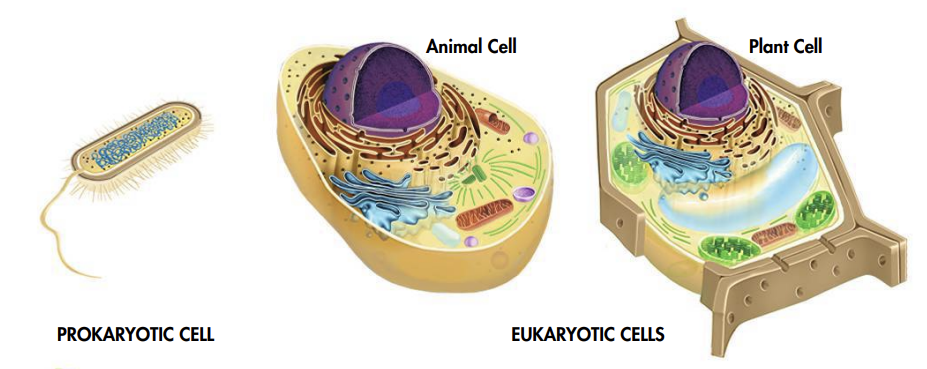
7.2 Cell Structure
Cell Organization
It’s easy to divide each eukaryotic cell into two major parts: the nucleus and the cytoplasm (the fluid portion of the cell outside the nucleus)
Prokaryotic cells have cytoplasm, too, even though they do not have a nucleus
Many structures in plant and animal cells act like specialized organs and are known as organelles - specialized structures that perform important cellular functions within a eukaryotic cell
The nucleus holds DNA and controls most of what goes on in the cell; the small, dense area in the nucleus is the nucleolus, where ribosomes are first put together
Ribosomes are used by the cell to build proteins
The nucleus is surrounded by a nuclear envelope made up of two membranes
The nuclear envelope is dotted with thousands of holes that allow material to move into and out of the nucleus
Organelles That Store, Clean Up, and Support
Many cells have large, membrane sacs called vacuoles that store materials like water, salts, proteins, and sugars
Plant cells carry a singular, large central vacuole filled with liquid
Some single-celled organisms have vacuoles; a paramecium, for example, has an organelle called a contractile vacuole that pumps extra water out of the cell by contracting over and over
Nearly all eukaryotic cells have much smaller membrane sacs called vesicles that store and move materials between organelles as well as to and from the outside of the cell
The lysosome is the cell organelle that breaks down lipids, carbohydrates, and proteins into small molecules that can be used by the rest of the cell
They remove “junk” that might otherwise pile up in the cell
Animal cells have lysosomes, and a few special kinds of plant cells also have them
A cytoskeleton is the network of protein filaments in a eukaryotic cell that gives the cell its shape and internal organization and is involved in movement
The cytoskeleton includes two types of protein filaments called microfilaments and microtubules
Microfilaments are threadlike structures made up of a protein called actin that supports the cell and helps some cells move
Microtubules are like thin, hollow pipes made up of proteins known as tubulins
Microtubules help the cell keep its shape and are also found in hairlike organelles called cilia and flagella that help some cells swim
In cell division, microtubules also form a structure known as the mitotic spindle that helps to separate the different sets of DNA that each daughter cell will get; in animal cells, organelles called centrioles are also formed from tubulins; plant cells do not have centrioles
Organelles That Build Proteins
Protein synthesis occurs on ribosomes - cell organelles consisting of RNA and proteins found throughout the cytoplasm in a cell
Many ribosomes are free in the cytoplasm, while others are attached to the endoplasmic reticulum
The endoplasmic reticulum (ER) is the internal membrane system found in eukaryotic cells and the place where lipid components of the cell membrane are assembled
Rough ER: Proteins are made on the rough ER; it is called “rough” because the ribosomes on its surface make it bumpy
Smooth ER: The smooth ER is called “smooth” because there are no ribosomes on its surface; in many cells, the smooth ER has groups of enzymes that make membrane lipids and get rid of toxins, such as drugs
The Golgi apparatus looks like a stack of flat membrane sacs and is an organelle in cells that modifies, sorts, and packages proteins and other materials from the endoplasmic reticulum for storage in the cell or release outside the cell
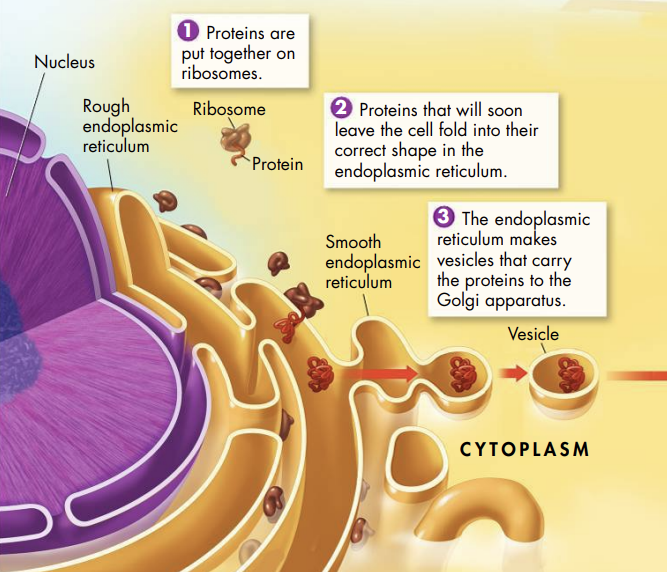
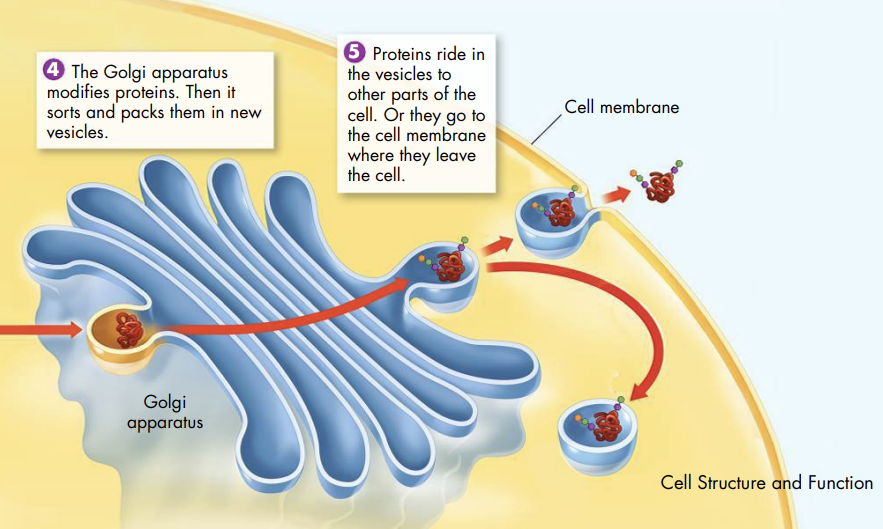
Organelles That Capture and Release Energy
Most cells are powered by food molecules that are built using energy from the sun
Plants and some other living things have chloroplasts - organelles found in cells of plants and some other organisms that capture the energy from sunlight and convert it into chemical energy in a process called photosynthesis
Inside the chloroplasts are large stacks of other membranes that hold the green pigment chlorophyll
Nearly all eukaryotic cells, including plant cells, have mitochondria - cell organelles that convert the chemical energy stored in food into compounds that are more convenient for the cell to use
Like chloroplasts, mitochondria are surrounded by two membranes—an outer membrane and an inner membrane
Both chloroplasts and mitochondria have their own genetic information in the form of small DNA molecules
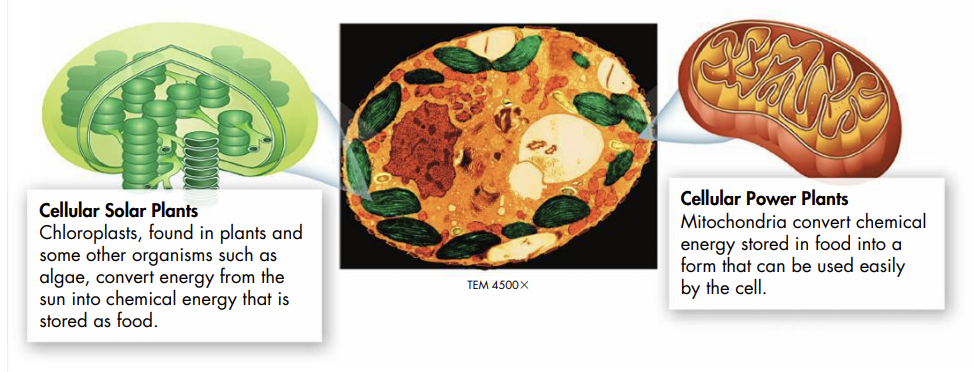
Cellular Boundaries
All cells are surrounded by a barrier known as the cell membrane, and many cells also have a stiff layer around the membrane known as a cell wall
The main job of the cell wall is to support, shape, and protect the cell
Most prokaryotes and many eukaryotes, such as plant cells, have cell walls, though animal cells do not have cell walls
The cell membrane keeps track of what enters and leaves the cell and also protects and supports the cell
Cell membranes are made up of a double-layered sheet called a lipid bilayer that makes membranes flexible and lets them form a strong barrier between the cell and its surroundings
The special lipids in the cell membrane have two parts: a head and a tail
The head is a chemical group that mixes well with water; it is called hydrophilic, or water-loving
The tail is made up of fatty acid chains that mix well with oil; it is called hydrophobic, or water-hating
When two of these layers come together, they are like a sandwich, with the water-loving parts of the lipids form the outside layer; the oily parts of the lipids stick together to form the inner layer, and a lipid bilayer is the result
The lipid bilayers of most cell membranes contain many different proteins, some of which form channels and pumps that help to move material across the cell membrane
If a substance is able to cross a membrane, the membrane is said to be permeable to it
A membrane is not permeable to substances that cannot pass across it
Most cell membranes are selectively permeable, which means that some substances can pass across them and others cannot
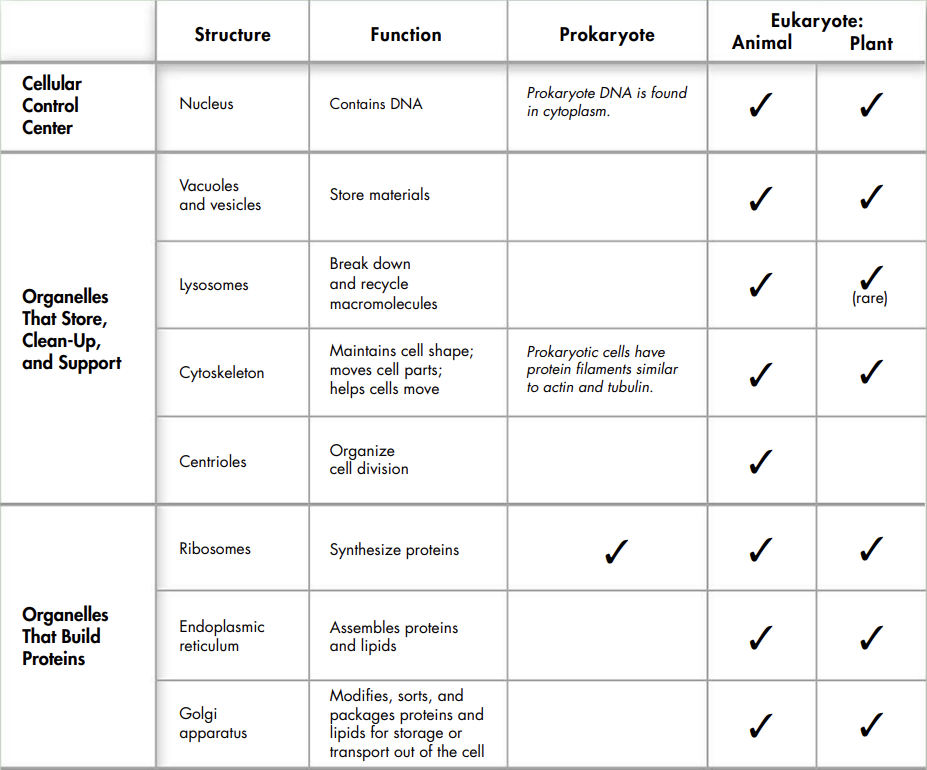
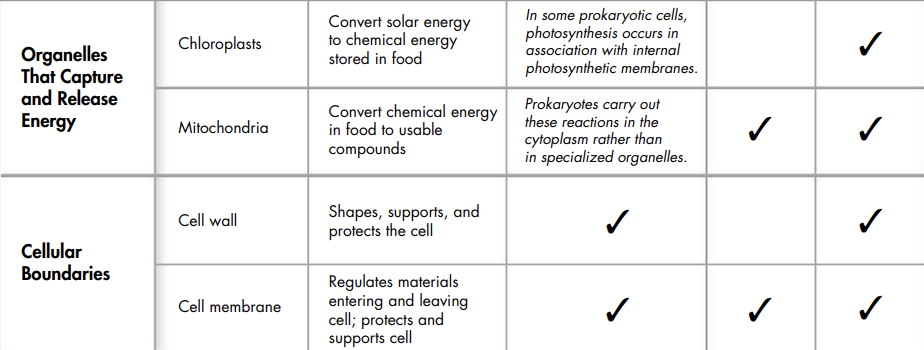
7.3 Cell Transport
Passive Transport
One of the most important jobs of the cell membrane is to keep up the right balance between the liquid in the cell and the liquid around the cell
Diffusion is the process by which molecules of a substance move from an area of higher concentration (where they are closer together) to an area of lower concentration (where they are more spread out)
Diffusion does not need energy from the cell; the movement of materials across the cell membrane without using cellular energy is called passive transport

Facilitated diffusion is the process of diffusion in which molecules pass across the membrane through cell membrane channels
This action does not use energy; therefore, facilitated diffusion is a form of passive transport
Osmosis is the diffusion of water through a selectively permeable membrane
In osmosis, as in all diffusion, molecules move from higher concentrations to lower concentrations—lower concentrations of water
Sometimes cell membranes have solutions that are the same on both sides, but sometimes the solutions are different
When the solutions inside and outside of the cell are the same, the solutions are said to be isotonic
When the solution outside of the cell has a higher concentration than the inside solution, the outside solution is hypertonic
When the solution outside of the cell has a lower concentration, it is hypotonic
Sometimes there are differences in concentration of salts, sugars, proteins, and other dissolved molecules on one side of the cell membrane that produce a force known as osmotic pressure - the pressure that must be applied to prevent osmotic movement across a selectively permeable membrane
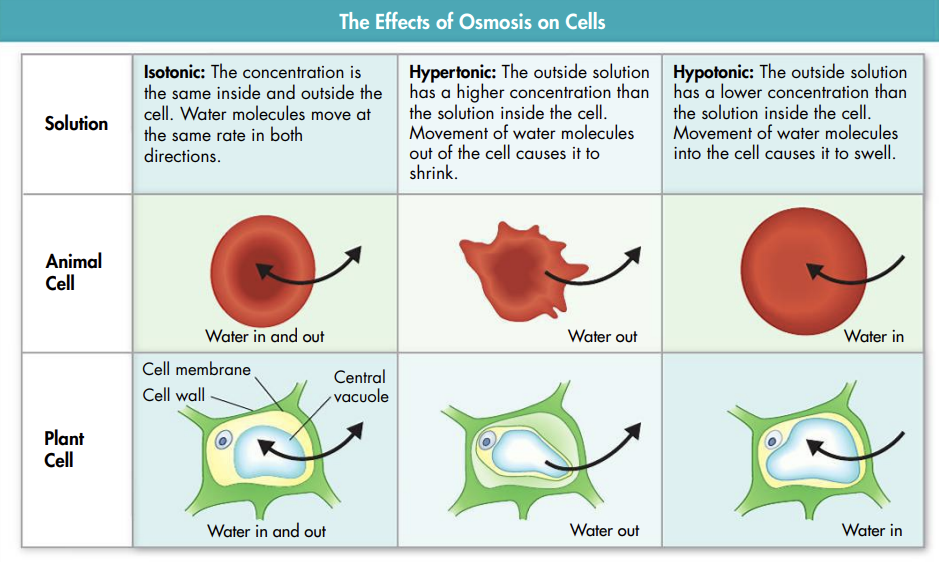
Active Transport
Active transport is the movement of particles from an area of lower concentration to an area of higher concentration across the cell membrane using energy
Small molecules or ions move across a cell membrane through the work of protein pumps found in the membrane
Larger molecules and big clumps of material can also be moved across the cell membrane through vesicles by processes known as endocytosis and exocytosis
Endocytosis is the process of taking material into the cell through a pocket of the cell membrane that folds into the cell; the pocket pinches off and breaks loose from the cell membrane before forming a vesicle or vacuole in the cytoplasm
Many cells release large amounts of material through a process known as exocytosis
Exocytosis is the opposite of endocytosis—materials leave the cell instead of coming into it
During exocytosis, the membrane of a vesicle sticks to and becomes part of the cell membrane; as the membranes fuse, the contents of the vesicle are forced out of the cell
Cells use exocytosis to get rid of wastes and to give off chemical signals
7.4 Homeostasis and Cells
The Cell as an Organism
To maintain homeostasis (relatively constant internal physical and chemical conditions), unicellular organisms grow, respond to the environment, change food or sunlight into useful energy, and reproduce
Single-celled organisms include both prokaryotes and eukaryotes
Multicellular Life
The cells of a many-celled organism are specialized for different jobs
From simplest to most complex, the levels of organization in a many-celled organism are cells, tissues, organs, and organ systems
A tissue is a group of similar cells that perform a particular function
An organ is a group of tissues that work together to perform closely related functions
An organ system is a group of organs that work together to perform a specific function
Cells in a large organism use chemical signals passed from one cell to another to communicate
In order to communicate, certain cells form connections, or cellular junctions, to neighboring cells some of which hold cells together firmly, and others that allow small molecules carrying chemical messages or signals to pass from one cell to the next
To “understand” one of these chemical signals, a cell must have a receptor that sticks to the chemical signal; some receptors are on the cell membrane, while other kinds of receptors are inside the cytoplasm
Chapter 7: Cell Structure and Function
7.1 Life is Cellular
The Discovery of the Cell
In 1665, Robert Hooke used a microscope to look at thin slices of cork from plants that seemed to be made of many tiny, empty boxes; Hooke called these boxes “cells,” and they are the basic units of life
The cell theory states that all living things are made up of cells, that cells are the basic units of structure and function in living things, and that new cells come from existing cells
Exploring the Cell
A microscope gives you a larger view of something very small, such as a cell
Light microscopes use glass lenses to focus light and magnify the object
Light microscopes can make clear images of objects only to a magnification of about 1000 times
Electron microscopes produce even higher magnifications by using electrons instead of light
Electron microscopes can show things that are 1 billionth of a meter in size
Transmission electron microscopes send beams of electrons through thin slices of cells and tissues
In scanning electron microscopes, a beam of electrons is scanned over the surface of an object to give a three-dimensional image of the object’s surface

Prokaryotes and Eukaryotes
Despite their differences, at some point in their lives, all cells have DNA - the molecule that carries genetic information; all cells are also surrounded by a thin, flexible barrier called a cell membrane
There are two main kinds of cells: one kind has a nucleus, and the other does not
The nucleus is a structure that contains the cell’s genetic material in the form of DNA and controls many of the cell’s activities
Eukaryotes are cells that enclose their DNA in nuclei
Prokaryotes are cells that do not have nuclei and their DNA is not separated from the rest of the cell
Eukaryotic cells are generally larger and more complex than prokaryotic cells
Eukaryotes can be very different from one another; some, like “protists,” live as single cells, while others make up large organisms with many cells (plants, animals, and fungi)
Prokaryotic cells are generally smaller and simpler than eukaryotic cells
Even though they are simpler than eukaryotes, prokaryotes do all the activities that living things must do to be called “alive:” they grow, reproduce, respond to the environment, and, in some cases, glide along surfaces or swim through liquids
The living things that we call bacteria are prokaryotes

7.2 Cell Structure
Cell Organization
It’s easy to divide each eukaryotic cell into two major parts: the nucleus and the cytoplasm (the fluid portion of the cell outside the nucleus)
Prokaryotic cells have cytoplasm, too, even though they do not have a nucleus
Many structures in plant and animal cells act like specialized organs and are known as organelles - specialized structures that perform important cellular functions within a eukaryotic cell
The nucleus holds DNA and controls most of what goes on in the cell; the small, dense area in the nucleus is the nucleolus, where ribosomes are first put together
Ribosomes are used by the cell to build proteins
The nucleus is surrounded by a nuclear envelope made up of two membranes
The nuclear envelope is dotted with thousands of holes that allow material to move into and out of the nucleus
Organelles That Store, Clean Up, and Support
Many cells have large, membrane sacs called vacuoles that store materials like water, salts, proteins, and sugars
Plant cells carry a singular, large central vacuole filled with liquid
Some single-celled organisms have vacuoles; a paramecium, for example, has an organelle called a contractile vacuole that pumps extra water out of the cell by contracting over and over
Nearly all eukaryotic cells have much smaller membrane sacs called vesicles that store and move materials between organelles as well as to and from the outside of the cell
The lysosome is the cell organelle that breaks down lipids, carbohydrates, and proteins into small molecules that can be used by the rest of the cell
They remove “junk” that might otherwise pile up in the cell
Animal cells have lysosomes, and a few special kinds of plant cells also have them
A cytoskeleton is the network of protein filaments in a eukaryotic cell that gives the cell its shape and internal organization and is involved in movement
The cytoskeleton includes two types of protein filaments called microfilaments and microtubules
Microfilaments are threadlike structures made up of a protein called actin that supports the cell and helps some cells move
Microtubules are like thin, hollow pipes made up of proteins known as tubulins
Microtubules help the cell keep its shape and are also found in hairlike organelles called cilia and flagella that help some cells swim
In cell division, microtubules also form a structure known as the mitotic spindle that helps to separate the different sets of DNA that each daughter cell will get; in animal cells, organelles called centrioles are also formed from tubulins; plant cells do not have centrioles
Organelles That Build Proteins
Protein synthesis occurs on ribosomes - cell organelles consisting of RNA and proteins found throughout the cytoplasm in a cell
Many ribosomes are free in the cytoplasm, while others are attached to the endoplasmic reticulum
The endoplasmic reticulum (ER) is the internal membrane system found in eukaryotic cells and the place where lipid components of the cell membrane are assembled
Rough ER: Proteins are made on the rough ER; it is called “rough” because the ribosomes on its surface make it bumpy
Smooth ER: The smooth ER is called “smooth” because there are no ribosomes on its surface; in many cells, the smooth ER has groups of enzymes that make membrane lipids and get rid of toxins, such as drugs
The Golgi apparatus looks like a stack of flat membrane sacs and is an organelle in cells that modifies, sorts, and packages proteins and other materials from the endoplasmic reticulum for storage in the cell or release outside the cell


Organelles That Capture and Release Energy
Most cells are powered by food molecules that are built using energy from the sun
Plants and some other living things have chloroplasts - organelles found in cells of plants and some other organisms that capture the energy from sunlight and convert it into chemical energy in a process called photosynthesis
Inside the chloroplasts are large stacks of other membranes that hold the green pigment chlorophyll
Nearly all eukaryotic cells, including plant cells, have mitochondria - cell organelles that convert the chemical energy stored in food into compounds that are more convenient for the cell to use
Like chloroplasts, mitochondria are surrounded by two membranes—an outer membrane and an inner membrane
Both chloroplasts and mitochondria have their own genetic information in the form of small DNA molecules

Cellular Boundaries
All cells are surrounded by a barrier known as the cell membrane, and many cells also have a stiff layer around the membrane known as a cell wall
The main job of the cell wall is to support, shape, and protect the cell
Most prokaryotes and many eukaryotes, such as plant cells, have cell walls, though animal cells do not have cell walls
The cell membrane keeps track of what enters and leaves the cell and also protects and supports the cell
Cell membranes are made up of a double-layered sheet called a lipid bilayer that makes membranes flexible and lets them form a strong barrier between the cell and its surroundings
The special lipids in the cell membrane have two parts: a head and a tail
The head is a chemical group that mixes well with water; it is called hydrophilic, or water-loving
The tail is made up of fatty acid chains that mix well with oil; it is called hydrophobic, or water-hating
When two of these layers come together, they are like a sandwich, with the water-loving parts of the lipids form the outside layer; the oily parts of the lipids stick together to form the inner layer, and a lipid bilayer is the result
The lipid bilayers of most cell membranes contain many different proteins, some of which form channels and pumps that help to move material across the cell membrane
If a substance is able to cross a membrane, the membrane is said to be permeable to it
A membrane is not permeable to substances that cannot pass across it
Most cell membranes are selectively permeable, which means that some substances can pass across them and others cannot


7.3 Cell Transport
Passive Transport
One of the most important jobs of the cell membrane is to keep up the right balance between the liquid in the cell and the liquid around the cell
Diffusion is the process by which molecules of a substance move from an area of higher concentration (where they are closer together) to an area of lower concentration (where they are more spread out)
Diffusion does not need energy from the cell; the movement of materials across the cell membrane without using cellular energy is called passive transport

Facilitated diffusion is the process of diffusion in which molecules pass across the membrane through cell membrane channels
This action does not use energy; therefore, facilitated diffusion is a form of passive transport
Osmosis is the diffusion of water through a selectively permeable membrane
In osmosis, as in all diffusion, molecules move from higher concentrations to lower concentrations—lower concentrations of water
Sometimes cell membranes have solutions that are the same on both sides, but sometimes the solutions are different
When the solutions inside and outside of the cell are the same, the solutions are said to be isotonic
When the solution outside of the cell has a higher concentration than the inside solution, the outside solution is hypertonic
When the solution outside of the cell has a lower concentration, it is hypotonic
Sometimes there are differences in concentration of salts, sugars, proteins, and other dissolved molecules on one side of the cell membrane that produce a force known as osmotic pressure - the pressure that must be applied to prevent osmotic movement across a selectively permeable membrane

Active Transport
Active transport is the movement of particles from an area of lower concentration to an area of higher concentration across the cell membrane using energy
Small molecules or ions move across a cell membrane through the work of protein pumps found in the membrane
Larger molecules and big clumps of material can also be moved across the cell membrane through vesicles by processes known as endocytosis and exocytosis
Endocytosis is the process of taking material into the cell through a pocket of the cell membrane that folds into the cell; the pocket pinches off and breaks loose from the cell membrane before forming a vesicle or vacuole in the cytoplasm
Many cells release large amounts of material through a process known as exocytosis
Exocytosis is the opposite of endocytosis—materials leave the cell instead of coming into it
During exocytosis, the membrane of a vesicle sticks to and becomes part of the cell membrane; as the membranes fuse, the contents of the vesicle are forced out of the cell
Cells use exocytosis to get rid of wastes and to give off chemical signals
7.4 Homeostasis and Cells
The Cell as an Organism
To maintain homeostasis (relatively constant internal physical and chemical conditions), unicellular organisms grow, respond to the environment, change food or sunlight into useful energy, and reproduce
Single-celled organisms include both prokaryotes and eukaryotes
Multicellular Life
The cells of a many-celled organism are specialized for different jobs
From simplest to most complex, the levels of organization in a many-celled organism are cells, tissues, organs, and organ systems
A tissue is a group of similar cells that perform a particular function
An organ is a group of tissues that work together to perform closely related functions
An organ system is a group of organs that work together to perform a specific function
Cells in a large organism use chemical signals passed from one cell to another to communicate
In order to communicate, certain cells form connections, or cellular junctions, to neighboring cells some of which hold cells together firmly, and others that allow small molecules carrying chemical messages or signals to pass from one cell to the next
To “understand” one of these chemical signals, a cell must have a receptor that sticks to the chemical signal; some receptors are on the cell membrane, while other kinds of receptors are inside the cytoplasm
 Knowt
Knowt
